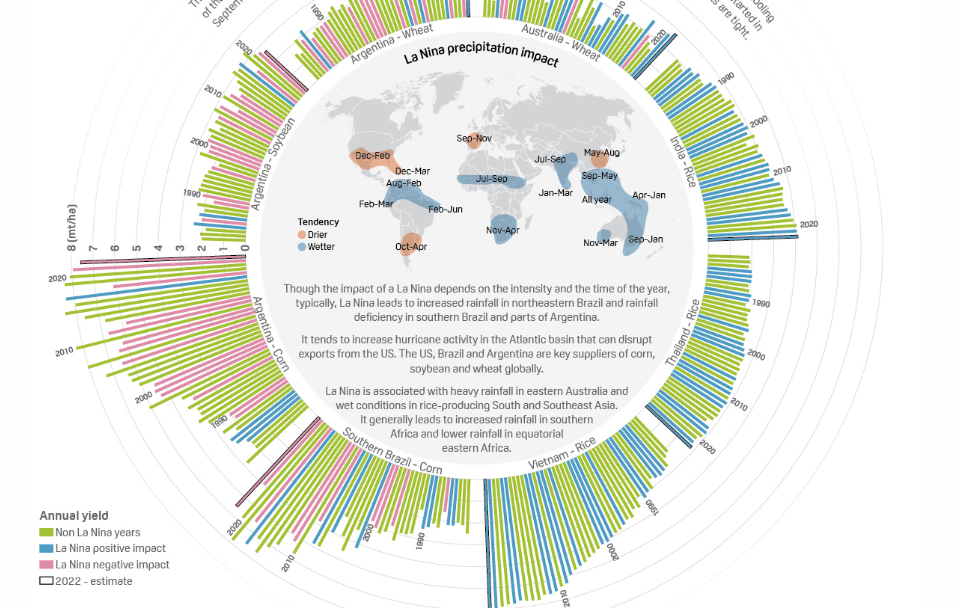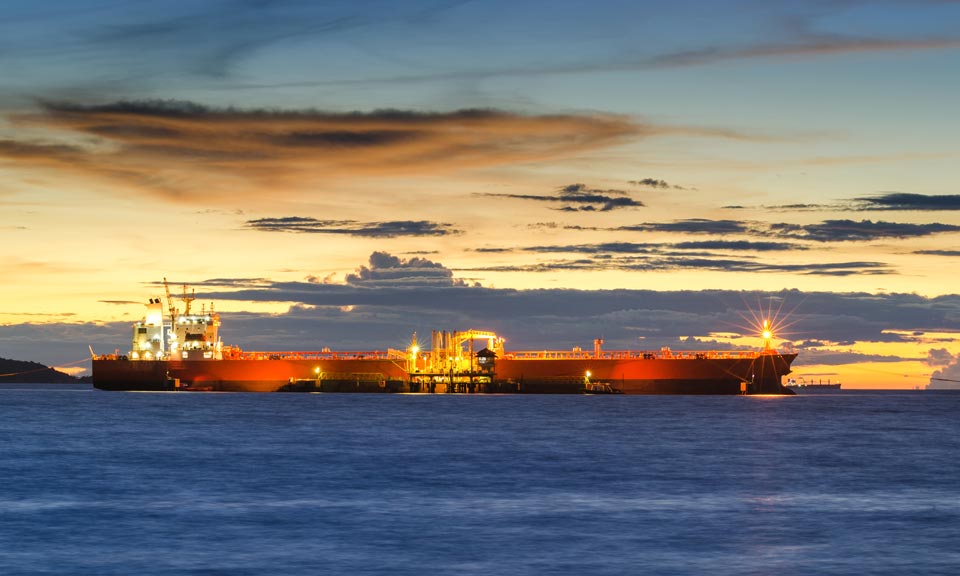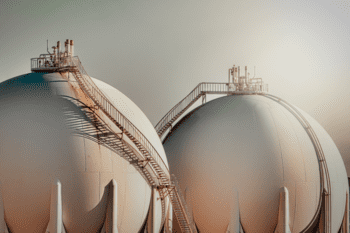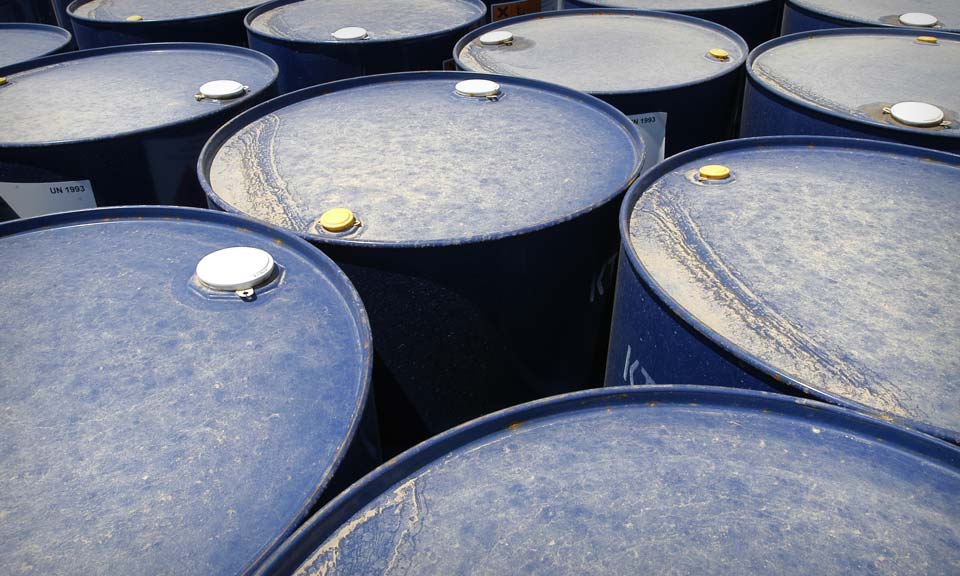Commodity markets in 2022: A year in 8 infographics

Another year rife in uncertainties and price volatility has passed for the energy, raw materials and shipping markets. Let's look back at some of the key movers and shakers of the year with a selection of S&P Global Commodity Insights infographics, developed by our editors and analysts, and designed by our data visualization experts.
Click the images to enlarge or interact.
Conflict in Ukraine following Russian troops launching attacks across international borders on Feb. 24, has had a major impact on prices of key commodities from oil and gas through to steel and grains. Europe is heavily reliant on gas and Urals crude via the Druzhba pipeline to refiners across the region.
Russia's invasion of Ukraine triggered an unprecedented wave of sanctions against Moscow which are still rippling through global commodity markets. In addition to official sanctions which continue to evolve, major self-sanctioning by industries looking to cut ties with Russia have deepened the market impact.
Click here to read key updates on the Russia-Ukraine war and its impact on commodities
Republicans have narrowly regained control of the US House of Representatives, portending robust oversight of Biden administration energy regulators in the next congressional session. But a razor-thin majority could complicate efforts to pass legislation affecting the energy sector, amid divisions within the Republican Party and challenges bringing progressive Democrats on board. The outcome leaves Washington with divided government, after Democrats narrowly kept control of the Senate earlier in the week.
Click here to read key updates on the US midterm election and its impact on energy policies
Asia's spot LNG procurement has nosedived since the Russian invasion of Ukraine, with the bulk of spot volumes diverted to Europe in the first half of 2022. India and China accounted for most of the decline in spot procurement, and price-sensitive importers like Bangladesh, Pakistan and Thailand are expected to be impacted by rising spot LNG prices this winter.
Read more: Energy in the new era
China has made adoption of electric vehicles a cornerstone of decarbonizing its transport sector. Despite headwinds such as removal of EV subsidies by year end and rising battery raw material prices, China's EV adoption rate is seen undented.
Read more: China decarbonization: Ironing out the snags
With economic and energy supply pressures dominating political agendas, environmental policies have taken a back seat in 2022 in the run up to COP27 in Egypt. Few new climate commitments have been made despite calls for annual evaluation of national plans at COP26 in Glasgow.
Click here for more of our COP27 coverage
The agriculture markets have been packed with headline-grabbing events, with extreme price volatility for all major grains and oil seeds in the last two years. The possibility of a continued La Nina is seen adding to the uncertainty. La Nina, Spanish for little girl, is a climate pattern having a varying impact on agriculture globally.
Russia's invasion of Ukraine sent agricultural commodities spiraling Feb. 24 following monthslong tensions in the Black Sea region that kept prices of key grains such as wheat highly volatile.
Click here for more S&P Global Commodity Insights Infographics

News
Russia, one of the world’s largest oil suppliers, has increasingly turned to non-Western firms to transport its crude to overseas buyers during its ongoing war with Ukraine . With a dual goal of undermining Russia’s war chest without creating significant disruptions to global supplies amid inflation pressure, G7 countries and their allies have banned tanker operators, insurers and other services firms from facilitating seaborne Russian crude exports unless the barrels are sold for no more than $60/b. The price cap regime, which came into force Dec. 5, 2022, does not directly cover tankers flagged, owned and operated by companies outside the G7, the EU, Australia, Switzerland and Norway, and not insured by Western protection and indemnity clubs. While such ships tend to be older and less maintained, their share in Russia’s crude exports market has been rising in recent months amid strengthening prices of Urals -- the OPEC+ member’s flagship crude grade -- and tightening sanctions enforcement by the West. Non-price-capped tankers have a larger market share in shipping Russia’s Pacific crude exports, according to analysis of S&P Global Commodities at Sea and Maritime Intelligence Risk Suite data. Crudes such as Sokol, Sakhalin Blend, and Eastern Siberia–Pacific Ocean grades are more often involved in these trades than Russian barrels from Baltic or Black Sea ports like Urals. Tanker operators in Greece, Europe’s top shipowning nation, managed to keep their traditionally strong market position in Russia in the first few months since the price cap took effect before giving ways to their peers in the UAE, Russia, China and Hong Kong. (Latest update: April 5, 2024)

News
Recording changes to Russian oil exports and EU oil imports since the war in Ukraine Russia’s war in Ukraine has triggered a major upheaval in the global oil markets, forcing Moscow to find alternative buyers and Europe to source new supplies as Western sanctions seek to clamp down on Moscow’s vital oil revenues. With an EU embargo and the G7 price cap on Moscow's oil now fully in place, Russian seaborne crude exports have remained largely resilient as displaced volumes of its discounted oil flow East. Russian oil product exports have also mostly held up with new buyers in Africa absorbing Russian diesel and other fuels now banned from Europe. (Latest update: April 3, 2024)

News
Initiative driven by demand for batteries from vehicles, energy storage IOC aims to be carbon-free by 2046 Tie-up comes as India supports NEV buildup Japan's Panasonic Energy and state-run Indian Oil Corp aim to finalize details for a joint-venture to manufacture cylindrical lithium-ion batteries in India as early as June to September, the Japanese battery maker said April 1. Both companies will engage in "a feasibility study regarding the utilization of battery technology to facilitate the transition to clean energy in India," Panasonic said, and have signed a binding term sheet with details to emerge "by the summer of this year." The initiative by the companies "is driven by the anticipated expansion of demand for batteries for two- and three-wheel vehicles and energy storage systems in the Indian market", it said. The collaboration comes as India takes steps to build up infrastructure for manufacturing and supporting new energy vehicles, especially in its interim budget for 2024-25. Following the budget announcement, Chinese automaker SAIC Motor and India's JSW Group plan to install a production capacity of 200,000 vehicles/year in India, focusing on NEVs, with ramping up to start from the end of 2024. In China, NEV is a term used to designate automobiles that are fully or predominantly powered by electricity and include battery electric vehicles as well as plug-in hybrid EVs and fuel cell EVs. IOC's tie-up with Panasonic will support the energy company's goals to be a zero-carbon emitter by 2046. India's lithium-ion battery manufacturing industry is expected to grow at a compound annual growth rate of 50% from 20 GWh in 2022 to 220 GWh by 2030, data from the India Brand Equity Foundation showed. Platts assessed prices for battery grade lithium carbonate at $14,350/mt CIF North Asia March 28, flat from the previous session, S&P Global Commodity Insights data showed, while lithium hydroxide stood at $14,000/mt CIF North Asia, also unchanged from the session before. Platts Connect: News & Insights (spglobal.com)

News
(Latest update March 28, 2024) OPEC+ ministers face the challenge of managing a slumping oil market as they discuss crude production for 2024. The following infographic highlights some key issues to watch out for during the upcoming talks. Related feature : OPEC+ committee meets as output cut policy finally boosts prices (subscriber content) Click for the full-size infographic